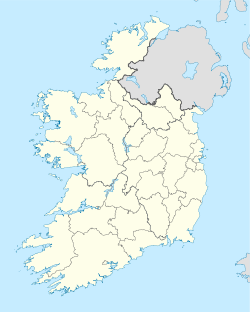- Clontibret
-
Clontibret
Cluain Tiobrad— Town — Location in Ireland Coordinates: 54°12′55.28″N 6°51′11.95″W / 54.2153556°N 6.8533194°WCoordinates: 54°12′55.28″N 6°51′11.95″W / 54.2153556°N 6.8533194°W Country Ireland Province Ulster County County Monaghan Population (2006) - Urban 300 Time zone WET (UTC+0) - Summer (DST) IST (WEST) (UTC-1) Irish Grid Reference Clontibret (Irish: Cluain Tiobrad, meaning "Well of the meadow") is a village and a parish in County Monaghan, Ireland.
Contents
Village
The village is situated close to the border with Northern Ireland, between the towns of Monaghan and Castleblayney, along the N2 National primary road, which links Dublin and Derry. The village population in 2006 was approximately 300.
Parish
Clontibret is a parish in the Diocese of Clogher. The Catholic parish has three churches - St. Mary's, north of Clontibret village, St. Michael's, in the nearby village of Annyalla and All Saints, in the village of Doohamlet, which is between the towns of Castleblayney and Ballybay. The Anglican Church of Ireland church is located on the ancient Christian site in Clontibret village. The wider parish area has a population of approximately 3,000 persons.
The Gaelic Athletic Association club in Clontibret is called Clontibret O'Neills (in honour of Hugh O'Neill Earl of Tyrone, victor at the Battle of Clontibret 1595).
History
In 1595 the adjacent countryside was the site of the Battle of Clontibret. The territory of Monaghan had been wrested from the control of the MacMahon clan in 1591, when the clan leader was executed by English authority. Subsequent encroachments by the English in to the province of Ulster led to the Nine Years War (1595–1603). The battle was the earliest clash between the two sides, with the Irish led by Hugh O'Neill and the English by Sir Henry Bagenal. Although O'Neill won the battle, the war ended with the completion of the English conquest of Ireland. In 1610 the Plantation of Ulster was established, an event that still defines certain political allegiances in the north of Ireland.
On 7 August 1986, in protest at the Anglo-Irish Agreement, Northern unionist politician Peter Robinson led an "invasion party" of 500 unionist militants into Clontibret and held a military parade with drill in the square, before being forced by the Gardaí to retreat back across the border. Irish authorities claimed that there were no more than 150 militants. Two Gardaí were beaten by the mob, while Robinson and others were arrested, tried, and eventually fined for the incident. Riots took place at Dundalk during the trial of Robinson, where Ian Paisley, then leader of the Democratic Unionist Party (DUP) was attacked with stones and petrol bombs.[1][2][3]
People
Clontibret was the birthplace of the famous historian and academic J. B. Bury (1861–1927). He was Professor of Roman History at Trinity College Dublin and later at Cambridge.
Another son of Clontibret was General John O'Neill, who led the ill-fated Fenian invasions of Canada in 1866, 1870 and 1871. He was born at Drumgallon in Clontibret in 1839. After a promising Army career in the American Civil War he joined forces with the Fenians and later established an Irish colony in Nebraska where today the city of O'Neill, Nebraska stands as a memorial to his endeavours on behalf of the Irish communities in the United States of America.
Roman Catholic Bishop Brendan Comiskey, former Bishop of Ferns, Co Wexford, was born in Tassan, Clontibret on 13 August 1935. He was auxiliary Bishop of Dublin from 1980 until his appointment to Ferns in 1984. He resigned as Bishop of Ferns in 2002 following allegations that he failed to deal adequately with complaints of child sexual abuse.
Another native of Tassan was Senator John Brennan, a Fianna Fáil member of Seanad Éireann from 1960 until 1977 and a member of Monaghan Co Council from 1942 until 1974.
Patrick Duffy, a seventeenth-century Roman Catholic Bishop of Clogher, is buried at what is now the Church of Ireland church.
Gold Discovery
Recently the village has been in the media spotlight due to the discovery of a major gold resource in the locality estimated in excess of 1 million ounces. This resource estimate, the result of ongoing work in the area by Dublin-based mineral exploration company Conroy Diamonds and Gold, is believed by the Company's directors to be the largest ever reported in Ireland and the UK.[4][5][6]
See also
References
- ^ CAIN chronology: August 1986
- ^ CAIN - Listing of Programmes for the Year: 1986
- ^ "Irish Protestants clash with Police" Associated Press, 8 August 1986
- ^ http://www.conroydiamondsandgold.com/news/files/News_Releases/NewsRelease1July2008.pdf
- ^ http://www.rte.ie/news/2008/0701/monaghan.html
- ^ http://news.bbc.co.uk/2/hi/uk_news/northern_ireland/7484495.stm
Places in County Monaghan County town: Monaghan Towns Villages
and townlandsAnnyalla • Ballinode • Castleshane • Clontibret • Corblonog • Corlat • Derryarrit • Emyvale • Glaslough • Inniskeen • Killycarnan • Killymarron • Knockacullion • Knockatallon • Newbliss • Rockcorry • Scotshouse • Scotstown • Sheskin • Skeatry • Smithborough • Tirnaneill • Tydavnet • TyhollandLandforms Black Pig's Dyke • Dartrey Forest • Dún na Rí Forest Park • Lough Egish • Rossmore Forest Park • Sliabh BeaghList of townlands in County Monaghan · Category:Mountains and hills of County Monaghan · Category:Geography of County Monaghan Categories:- Towns and villages in County Monaghan
Wikimedia Foundation. 2010.


